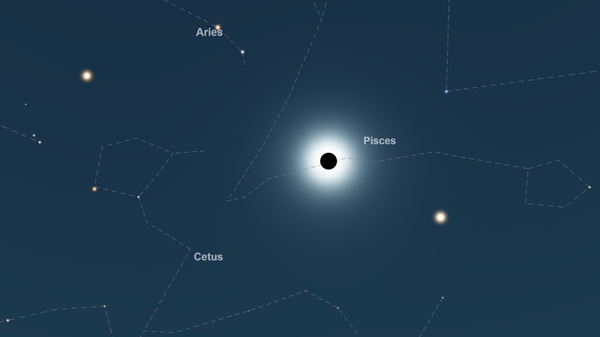The Comet Sharing the Stage with a Solar Eclipse
A comet may become visible in the night sky around the time of April’s solar eclipse. But that doesn’t necessarily mean it’s wise to look for it during totality.

Known as 12P/Pons-Brooks, the comet will be between Jupiter—on the left—and the eclipsed Sun on April 8. The bright planet to the right of the Sun is Venus. (Note: The sizes of the celestial bodies have been artificially exaggerated in order to show their relative positions more clearly.)
©timeanddate.com
Find 12P/Pons-Brooks in our Night Sky Map
Recently, a comet that will be close to the Earth during April’s eclipse has garnered a lot of media attention.
12P/Pons-Brooks is a periodic comet that is scheduled to reach perihelion, the point when it is closest to the Sun, on April 21, just 13 days after the total solar eclipse on April 8, 2024.
The 7 best places to see the eclipse
How San Antonio lost the 2024 Great American Eclipse
Difficult to Spot During Totality
This timing means the comet may be faintly visible between Jupiter and the Sun in our eclipse-darkened sky. But, despite the publicity for the chance of an eclipse appearance, timeanddate’s Graham Jones cautions that sighting this streaking clump of rock, dust, and ice may prove a bit underwhelming.
“The sky doesn’t go completely dark during a total eclipse, so the comet will likely be difficult to spot,” he says. “Having said that, this comet has had some dramatic outbursts, where it flares up and becomes brighter. One thing we can safely say is that comets are famous for their unpredictable nature.”
So, a daytime eclipse may not be the best time to do your comet-searching—you are more likely to be able to pick one out in the darkness of a night sky.
A Word of Caution
But if you do scan for 12P/Pons-Brooks during the event on April 8, be sure to care for your eye safety. It is extremely dangerous to point binoculars or telescopes anywhere near the direction of the Sun—this should only ever be done by experienced observers using proper equipment in a safe and secure way.
How to protect your eyes during solar eclipses
Colorful Flares
Astronomers have been tracking this comet closely as it nears Earth. In recent months, scientists have noted that it has displayed colorful flare-ups in blue, red, and green. And it is becoming easier to see for amateur astronomers too. Right now, you can use a telescope to look for 12P/Pons-Brooks in the constellation of Pisces. However, by early April it will have moved into the neighboring constellation of Aries.